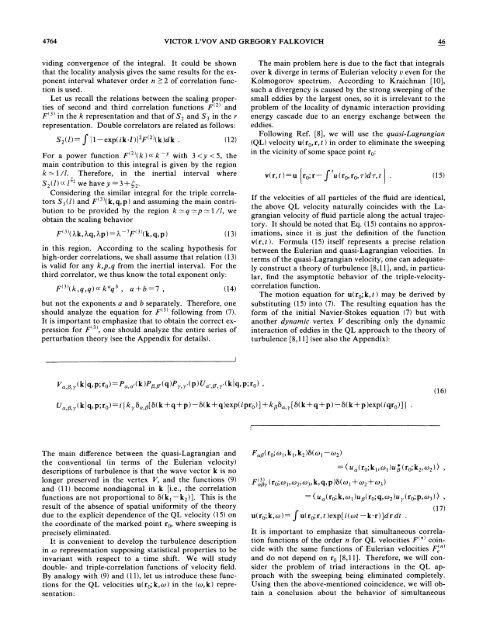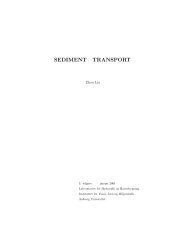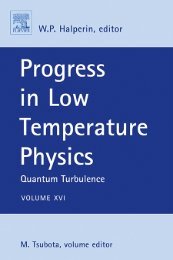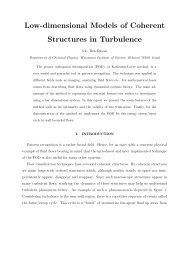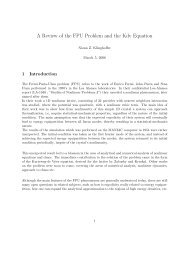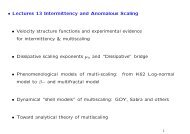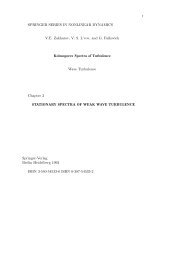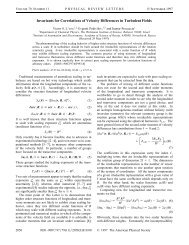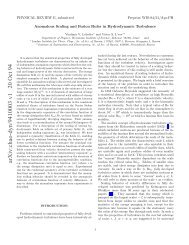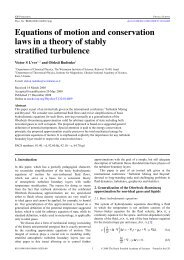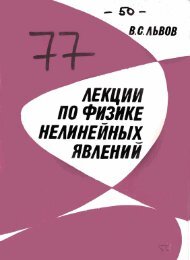Phys. Rev. A - Victor S. L'vov Home-page - Weizmann Institute of ...
Phys. Rev. A - Victor S. L'vov Home-page - Weizmann Institute of ...
Phys. Rev. A - Victor S. L'vov Home-page - Weizmann Institute of ...
Create successful ePaper yourself
Turn your PDF publications into a flip-book with our unique Google optimized e-Paper software.
4764 VICTOR L'VOV AND GREGORY FALKOVICH 46<br />
viding convergence <strong>of</strong> the integral. It could be shown<br />
that the locality analysis gives the same results for the exponent<br />
interval whatever order n 12 <strong>of</strong> correlation function<br />
is used.<br />
Let us recall the relations between the scaling properties<br />
<strong>of</strong> second and third correlation functions F'~' and<br />
F'~' in the k representation and that <strong>of</strong> S, and Sj in the r<br />
representation. Double correlators are related as follows:<br />
For a power function F'~'( k ) a k -y with 3 < y < 5, the<br />
main contribution to this integral is given by the region<br />
k -- + l/l. Therefore, in the inertial interval where<br />
S,(I)~I~~ we havey=3+f,.<br />
Considering the similar integral for the triple correlators<br />
S3( 1 ) and F'~'( k,q,p ) and assuming the main contributron<br />
to be provided by the region k = q --p -- 1 / I, we<br />
obtain the scaling behavior<br />
F'~'( hk, hq, hp) = h-'~'~)(k,q,p) (13)<br />
in this region. According to the scaling hypothesis for<br />
high-order correlations, we shall assume that relation (13)<br />
is valid for any k,p,q from the inertial interval. For the<br />
third correlator, we thus know the total exponent only:<br />
but not the exponents a and b separately. Therefore, one<br />
should analyze the equation for F'~' following from (7).<br />
It is important to emphasize that to obtain the correct expression<br />
for F'~', one should analyze the entire series <strong>of</strong><br />
perturbation theory (see the Appendix for details).<br />
The main difference between the quasi-Lagrangian and<br />
the conventional (in terms <strong>of</strong> the Eulerian velocity)<br />
descriptions <strong>of</strong> turbulence is that the wave vector k is no<br />
longer preserved in the vertex V, and the functions (9)<br />
and (1 1) become nondiagonal in k [i.e., the correlation<br />
functions are not proportional to 6(k,-k,)]. This is the<br />
result <strong>of</strong> the absence <strong>of</strong> spatial uniformity <strong>of</strong> the theory<br />
due to the explicit dependence <strong>of</strong> the QL velocity (15) on<br />
the coordinate <strong>of</strong> the marked point r,, where sweeping is<br />
precisely eliminated.<br />
It is convenient to develop the turbulence description<br />
in w representation supposing statistical properties to be<br />
invariant with respect to a time shift. We will study<br />
double- and triple-correlation functions <strong>of</strong> velocity field.<br />
By analogy with (9) and (1 11, let us introduce these func-<br />
tions for the QL velocities u(r,; k, w) in the (w,kj repre-<br />
sentation:<br />
The main problem here is due to the fact that integrals<br />
over k diverge in terms <strong>of</strong> Eulerian velocity v even for the<br />
Kolmogorov spectrum. According to Kraichnan [lo],<br />
such a divergency is caused by the strong sweeping <strong>of</strong> the<br />
small eddies by the largest ones, so it is irrelevant to the<br />
problem <strong>of</strong> the locality <strong>of</strong> dynamic interaction providing<br />
energy cascade due to an energy exchange between the<br />
eddies.<br />
Following Ref. [8], we will use the quasi-Lagrangian<br />
(QL) velocity u(r,,r,t) in order to eliminate the sweeping<br />
in the vicinity <strong>of</strong> some space point r,:<br />
If the velocities <strong>of</strong> all particles <strong>of</strong> the fluid are identical,<br />
the above QL velocity naturally coincides with the La-<br />
grangian velocity <strong>of</strong> fluid particle along the actual trajec-<br />
tory. It should be noted that Eq. (15) contains no approx-<br />
imations, since it is just the definition <strong>of</strong> the function<br />
v( r, t 1. Formula (15) itself represents a precise relation<br />
between the Eulerian and quasi-Lagrangian velocities. In<br />
terms <strong>of</strong> the quasi-Lagrangian velocity, one can adequate-<br />
ly construct a theory <strong>of</strong> turbulence [8,11], and, in particu-<br />
lar, find the asymptotic behavior <strong>of</strong> the triple-velocity-<br />
correlation function.<br />
The motion equation for u(r,,;k,t ) may be derived by<br />
substituting (15) into (7). The resulting equation has the<br />
form <strong>of</strong> the initial Navier-Stokes equation (7) but with<br />
another dynamic vertex V describing only the dynamic<br />
interaction <strong>of</strong> eddies in the QL approach to the theory <strong>of</strong><br />
turbulence [8,11] (see also the Appendix):<br />
It is important to emphasize that simultaneous correla-<br />
tion functions <strong>of</strong> the order n for QL velocities F'"' coin-<br />
cide with the same functions <strong>of</strong> Eulerian velocities F:"'<br />
and do not depend on r, [8,11]. Therefore, we will con-<br />
sider the problem <strong>of</strong> triad interactions in the QL ap-<br />
proach with the sweeping being eliminated completely.<br />
Using then the above-mentioned coincidence, we will ob-<br />
tain a conclusion about the behavior <strong>of</strong> simultaneous


